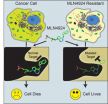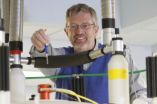Review of multilevel surgery in patients with obstructive sleep apnea
2012-03-20
(Press-News.org) CHICAGO – Patients with obstructive sleep apnea who undergo surgery for their condition should be closely monitored after their procedures are performed but may not need to be in an intensive care unit, according to a report published Online First by Archives of Otolaryngology – Head & Neck Surgery, one of the JAMA/Archives journals.
Surgical procedures in patients with sleep apnea (a sleep disorder characterized by pauses in breathing) have traditionally been considered dangerous and potentially life threatening if not monitored with caution because these patients are at higher risk for airway compromise postoperatively, the authors write in their study background.
Kenny P. Pang, F.R.C.S.Ed., F.R.C.S.I.(OTO), of the Pacific Sleep Centre, Singapore, and colleagues conducted a retrospective review of 487 patients with obstructive sleep apnea (OSA) who underwent surgical procedures from January 2007 to May 2010. Multilevel OSA surgery included nasal, palate and tongue procedures. The overall complication rate was 7.1 percent, the authors note.
"Patients with OSA typically have small retrognathic mandibles (lower jaw) with difficult airways and, hence, present as difficult intubations to the anesthesiologists," the authors comment. "In addition, respiratory depression from anesthetic agents like muscle relaxants and narcotics are well documented in these patients."
The authors note that while routine postoperative admission to the intensive care unit for all patients with OSA might not be necessary, they suggest that all patients with OSA be closely monitored in the recovery or high-dependency area (step-down care from intensive care unit) for at least three hours after surgery.
"In conclusion, we strongly recommended that the clinician manage the patient with OSA with caution and prudence, with the understanding that these patients have a higher risk of airway compromise and respiratory depression intraoperatively and postoperatively," the authors conclude.
###
(Arch Otolaryngol Head Neck Surg. Published online March 19, 2012. doi:10.1001/archoto.2012.130. Available pre-embargo to the media at www.jamamedia.org.)
Editor's Note: Please see the article for additional information, including other authors, author contributions and affiliations, financial disclosures, funding and support, etc.
To contact corresponding author Kenny P. Pang, F.R.C.S.Ed., F.R.C.S.I.(OTO) email kennypang@hotmail.com.
END
ELSE PRESS RELEASES FROM THIS DATE:
2012-03-20
A Harvard archaeologist has dramatically simplified the process of finding early human settlements by using computers to scour satellite images for the tell-tale clues of human habitation, and in the process uncovered thousands of new sites that might reveal clues to the earliest complex human societies.
As described in a paper published March 19 in the Proceedings of the National Academy of Sciences, Jason Ur, the John L. Loeb Associate Professor of the Social Sciences, worked with Bjoern Menze, a research affiliate in MIT's Computer Science and Artificial Intelligence ...
2012-03-20
LA JOLLA, Calif., March 19, 2012 – Drug resistance is a serious problem for cancer patients—over time, a therapy that was once providing some benefit simply stops working. Scientists at Sanford-Burnham Medical Research Institute (Sanford-Burnham) recently discovered how cancer cells develop resistance to a drug called MLN4924. This experimental therapy is currently being tested in a number of Phase I and Phase I/II clinical trials to determine its efficacy against several different types of cancer, including multiple myeloma, leukemia, and lymphoma.
Published online March ...
2012-03-20
How and when our blood clots is one of those incredibly complex and important processes in our body that we rarely think about. If your blood doesn't clot and you cut yourself, you could bleed to death, if your blood clots too much, you could be in line for a heart attack or stroke. Dr. Hans Vogel, a professor at the University of Calgary, has thought a lot about blot clotting and recently published research in the prestigious Journal of the American Chemical Society that helps to better understand the clotting process.
Vogel and his graduate student Hao Huang were able ...
2012-03-20
Just like a road atlas faithfully maps real-word locations, our brain maps many aspects of our physical world: Sensory inputs from our fingers are mapped next to each other in the somatosensory cortex; the auditory system is organized by sound frequency; and the various tastes are signaled in different parts of the gustatory cortex.
The olfactory system was believed to map similarly, where groups of chemically related odorants - amines, ketones, or esters, for example - register with clusters of cells that are laid out next to each other.
When researchers at the Stowers ...
2012-03-20
University of Granada researchers have developed a software tool that makes an accurate estimation of the risk that a person has to suffer a heart disease. In addition, this software tool allows the performance of massive risk estimations, i.e. it helps estimating the risk that a specific population group has of suffering a heart condition. The researchers employed a sample including 3 000 patients.
Heart conditions increasingly affect working age population, which can make individuals loss potential years of work and productivity.
Understanding the risk for ...
2012-03-20
The new political appetite for 'localism' in town planning has triggered anxiety within local communities and amongst those charged with making it work, according to new research funded by the Economic and Social Research Council (ESRC).
A study led by Professor Nick Gallent of the Bartlett School of Planning, University College London, looked at how communities in Kent have sought to influence the policies of local authorities and service providers and how, in the recent past, they have engaged with planning professionals around the production of 'parish plans'. The ...
2012-03-20
Researchers in Wales and the United States have collaborated to complete the first high-resolution, comprehensive genetic map of a promising energy crop called miscanthus. The results – published in the current edition of the peer-reviewed, online journal PLoS One – provide a significant breakthrough towards advancing the production of bioenergy.
The breakthrough results from the long-term collaboration between energy crop company Ceres, Inc., based in Thousand Oaks, California, USA, and the Institute of Biological, Environmental and Rural Sciences (IBERS) at Aberystwyth ...
2012-03-20
Patients with relapsing onset Multiple Sclerosis (MS) who consumed alcohol, wine, coffee and fish on a regular basis took four to seven years longer to reach the point where they needed a walking aid than people who never consumed them. However the study, published in the April issue of the European Journal of Neurology, did not observe the same patterns in patients with progressive onset MS.
The authors say that the findings suggest that different mechanisms might be involved in how disability progresses in relapsing and progressive onset MS.
Researchers asked patients ...
2012-03-20
Scientists are one step closer to making more complex microscopic biological machines, following improvements in the way that they can "re-wire" DNA in yeast, according to research published today in the journal PLoS ONE.
The researchers, from Imperial College London, have demonstrated a way of creating a new type of biological "wire", using proteins that interact with DNA and behave like wires in electronic circuitry. The scientists say the advantage of their new biological wire is that it can be re-engineered over and over again to create potentially billions of connections ...
2012-03-20
A clock accurate to within a tenth of a second over 14 billion years – the age of the universe – is the goal of research being reported this week by scientists from three different institutions. To be published in the journal Physical Review Letters, the research provides the blueprint for a nuclear clock that would get its extreme accuracy from the nucleus of a single thorium ion.
Such a clock could be useful for certain forms of secure communication – and perhaps of greater interest – for studying the fundamental theories of physics. A nuclear clock could be as much ...
LAST 30 PRESS RELEASES:
[Press-News.org] Review of multilevel surgery in patients with obstructive sleep apnea



